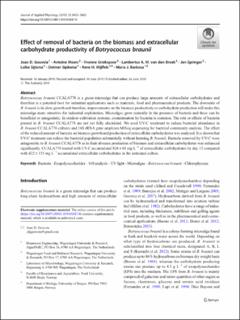| dc.contributor.author | Gouveia, João Diogo | |
| dc.contributor.author | Moers, Antoine | |
| dc.contributor.author | Griekspoor, Yvonne | |
| dc.contributor.author | van den Broek, Lambertus A.M. | |
| dc.contributor.author | Springer, Jan | |
| dc.contributor.author | Sijtsma, Lolke | |
| dc.contributor.author | Sipkema, Detmer | |
| dc.contributor.author | Wijffels, Rene Hubertus | |
| dc.contributor.author | Barbosa, Maria | |
| dc.date.accessioned | 2020-06-04T13:19:14Z | |
| dc.date.available | 2020-06-04T13:19:14Z | |
| dc.date.created | 2019-09-05T17:51:32Z | |
| dc.date.issued | 2019 | |
| dc.identifier.citation | Gouveia, J. D., Moers, A., Griekspoor, Y., van den Broek, L. A. M., Springer, J., Sijtsma, L., Sipkema, D., Wijffels, R. H. & Barbosa, M. (2019). Effect of removal of bacteria on the biomass and extracellular carbohydrate productivity of Botryococcus braunii. Journal of Applied Phycology, 31, 3453-3463. doi: | en_US |
| dc.identifier.issn | 1573-5176 | |
| dc.identifier.uri | https://hdl.handle.net/11250/2656613 | |
| dc.description.abstract | Botryococcus braunii CCALA778 is a green microalga that can produce large amounts of extracellular carbohydrates and therefore is a potential host for industrial applications such as materials, food and pharmaceutical products. The downside of B. braunii is its slow growth and therefore, improvements on the biomass productivity or carbohydrate production will make this microalga more attractive for industrial exploitation. Microalgae grow naturally in the presence of bacteria and these can be beneficial or antagonistic. In outdoor cultivation systems, contamination by bacteria is common. The role or effects of bacteria present in B. braunii CCALA778 are not yet fully elucidated. We used UV-C treatment to reduce bacterial abundance in B. braunii CCALA778 cultures and 16S rRNA gene amplicon MiSeq sequencing for bacterial community analysis. The effect of the reduced amount of bacteria on biomass growth and production of extracellular carbohydrates was analysed. It is shown that UV-C treatment can reduce the bacterial population substantially without harming B. braunii. Bacteria removed by UV-C were antagonistic to B. braunii CCALA778 as in their absence production of biomass and extracellular carbohydrates was enhanced significantly. CCALA778 treated with UV-C accumulated 826 ± 61 mg L−1 of extracellular carbohydrates by day 15 compared with 422 ± 135 mg L−1 accumulated extracellular carbohydrates in the untreated culture. | en_US |
| dc.publisher | Springer | en_US |
| dc.rights | Navngivelse 4.0 Internasjonal | * |
| dc.rights.uri | http://creativecommons.org/licenses/by/4.0/deed.no | * |
| dc.title | Effect of removal of bacteria on the biomass and extracellular carbohydrate productivity of Botryococcus braunii | en_US |
| dc.type | Peer reviewed | en_US |
| dc.type | Journal article | en_US |
| dc.description.version | publishedVersion | en_US |
| dc.rights.holder | © 2019 The Author(s) | en_US |
| dc.subject.nsi | VDP::Matematikk og Naturvitenskap: 400::Basale biofag: 470 | en_US |
| dc.source.pagenumber | 3453-3463 | en_US |
| dc.source.volume | 31 | en_US |
| dc.source.journal | Journal of Applied Phycology | en_US |
| dc.identifier.doi | 10.1007/s10811-019-01847-0 | |
| dc.identifier.cristin | 1722028 | |
| dc.relation.project | EC/FP7/311956 | en_US |

